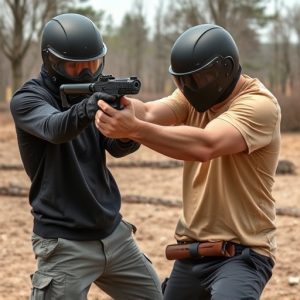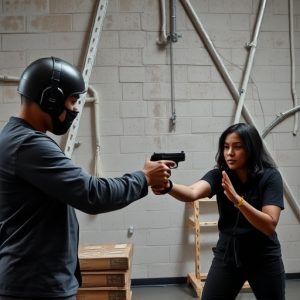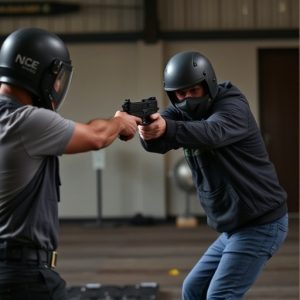Projectile vs Contact Stun Weapons: Safety, Power, & Disarm Compared
This text compares projectile (stun guns, tasers) and contact (batons, electric handcuffs) stun weap…….
This text compares projectile (stun guns, tasers) and contact (batons, electric handcuffs) stun weapons, highlighting their advantages and safety considerations. Key features of best safety features in stun guns include trigger locks, smart sensors, high-amp output, and durable construction for responsible deployment. Contact stun devices excel through direct impact, instant disarmament potential, and no aiming required, but may cause more severe injuries. Stun guns are non-lethal options with impressive range, power, and accuracy due to advanced engineering and safety features like adjustable shock strength and intentional activation switches. Selecting a stun gun with robust safety features is crucial for effective yet responsible self-defense.
In the realm of personal defense, stun weapons have emerged as powerful tools, offering alternatives to traditional firearms. This article explores the critical distinction between projectile and contact stun devices, delving into their unique mechanisms and safety features. From range and power to user-friendly design, we analyze how each type ensures best safety practices in stun guns. Understanding these differences is essential for individuals seeking effective self-defense options while prioritizing both personal and bystander safety.
- Understanding Projectile and Contact Stun Weapons: Key Differences
- Safety Features in Projectile Stun Guns: Protecting Users and Bystanders
- Advantages of Contact Stun Devices: Direct Impact and Instant Disarm
- Comparative Analysis: Range, Power, and Accuracy in Stun Weapons
- Choosing the Best Stun Gun: Factors to Consider for Optimal Safety
Understanding Projectile and Contact Stun Weapons: Key Differences
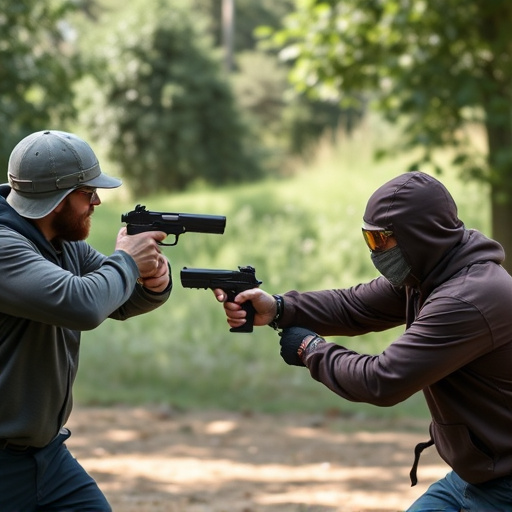
Projectile and contact stun weapons are distinct in their mode of operation, each with unique advantages and considerations. Projectile stun devices, such as stun guns or tasers, use electrical current to disrupt muscle control, causing the target to experience temporary incapacitation. These weapons fire a charged probe or projectile that makes physical contact with the target, delivering a powerful shock from a distance. On the other hand, contact stun weapons, like batons or electric handcuffs, rely on direct physical impact to stun. They use electrical current to overload the nervous system when pressed against the body, rendering the target unconscious without leaving permanent marks.
When considering the best safety features in stun guns or any stun weapon, understanding these differences is key. Projectile weapons offer a safer option for self-defense as they create distance between the user and the target, reducing the risk of physical harm during use. Contact stun devices, while effective, may result in more severe injuries if not used properly due to their direct impact nature. Therefore, users should prioritize safety features like built-in safety mechanisms, control settings, and training to ensure responsible and effective deployment.
Safety Features in Projectile Stun Guns: Protecting Users and Bystanders
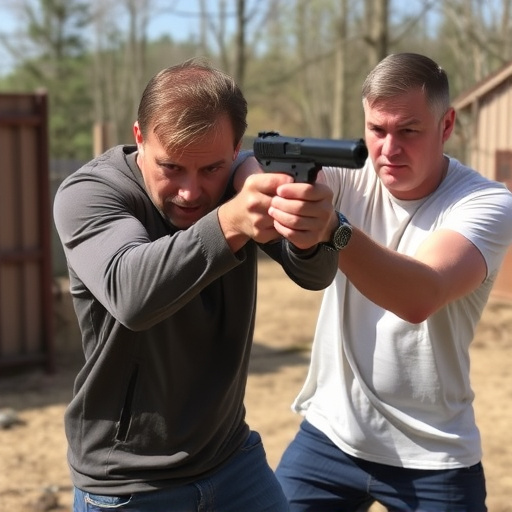
Stun guns equipped with safety features are designed to protect both users and bystanders, making them a more responsible choice for self-defense. Among the best safety features in stun guns are trigger locks and safety switches. Trigger locks prevent accidental discharges, ensuring that the device is only activated when intended. Safety switches, often requiring two hands to activate, add an extra layer of control, minimizing the risk of misuse. Some models also incorporate smart sensors that detect body heat or movement, firing only when a valid target is present, thus reducing harm to bystanders.
Additionally, stun guns with built-in flashlights not only enhance visibility but also serve as a deterrent, providing users with a clearer view during potential encounters. High-amp output and durable construction further contribute to safety by ensuring the device delivers a powerful shock while remaining reliable in various conditions. These safety features make projectile stun guns a more controlled and responsible option for personal protection compared to contact stun weapons.
Advantages of Contact Stun Devices: Direct Impact and Instant Disarm
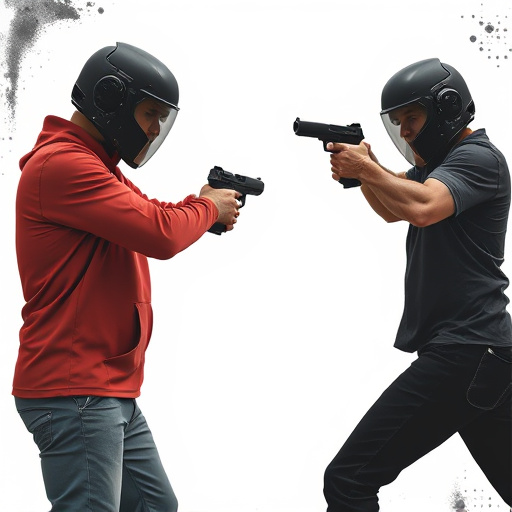
Contact stun devices, like stun guns, offer several advantages over projectile-based stun weapons. One of their key strengths is direct impact. When deployed, a stun gun makes physical contact with the target, delivering an electric shock that overrides motor functions. This immediate and tangible effect ensures a swift incapacitation, making it ideal for self-defense scenarios where every second counts.
Moreover, these devices provide instant disarmament potential. Unlike projectiles that might be deflected or avoided, a stun device requires no aiming; it’s activated upon contact. This feature not only makes them highly effective in close-quarters encounters but also enhances user safety by minimizing the risk of collateral damage. The best safety features in stun guns often include trigger safety mechanisms and built-in controls to prevent accidental deployment, ensuring responsible use.
Comparative Analysis: Range, Power, and Accuracy in Stun Weapons
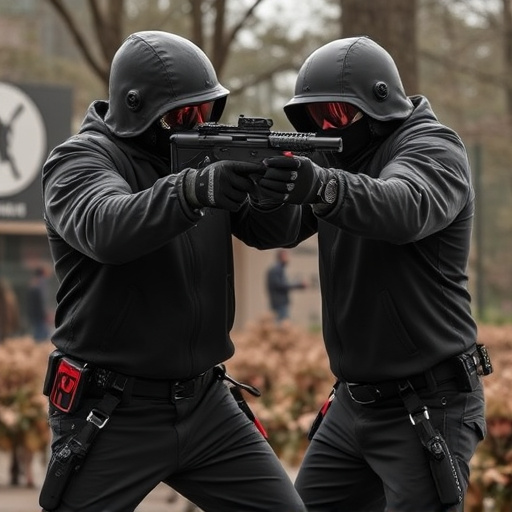
In the realm of personal defense, stun weapons offer a non-lethal alternative to traditional firearms. When comparing projectile and contact stun devices, the discussion revolves around range, power, and accuracy. Stun guns, as a popular choice, boast an impressive range, allowing users to disable aggressors from a distance of up to 20 feet or more, depending on the model. This long-range capability is especially appealing for self-defense scenarios where a swift response is crucial.
In terms of power and accuracy, stun guns excel due to their best safety features—they are designed to temporarily paralyze an individual without causing permanent harm. The electric current delivered by these devices disrupts muscle control, ensuring the target is neutralized effectively. Moreover, advanced models incorporate precision engineering, resulting in improved accuracy, enabling users to aim with confidence and reduce the risk of collateral damage or misfire.
Choosing the Best Stun Gun: Factors to Consider for Optimal Safety

When selecting a stun gun, prioritizing best safety features is paramount to ensure responsible and effective use. Key factors include the device’s shock strength, designed to temporarily incapacitate without causing serious harm, and its range—the distance at which it can effectively deploy its stun charge. Look for models with safety switches that require intentional activation, preventing accidental discharges. Additionally, consider stun guns with built-in LED flashlights, offering enhanced visibility during low-light situations, a practical feature that bolsters overall safety.
The design and build quality also contribute to safety. Lightweight yet durable construction ensures easy handling while reducing the risk of injury during use. Some models incorporate advanced features like multiple shock settings, allowing users to adjust the intensity based on the situation, further emphasizing responsible stun gun usage. Always opt for reputable brands known for their commitment to user safety and reliability in their stun weapon designs.
When choosing between projectile and contact stun weapons, understanding their distinct features and advantages is key. Projectile guns offer a safer range of protection, while contact devices provide immediate disarmament and direct impact. The best stun gun incorporates optimal safety features, ensuring effective deterrence without endangering bystanders. By considering factors like power, accuracy, and user safety, individuals can select the ideal stun weapon to suit their needs, ultimately prioritizing both personal security and responsible ownership.
